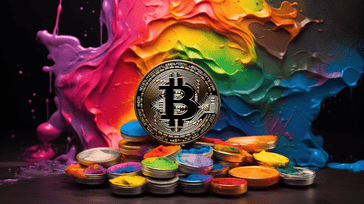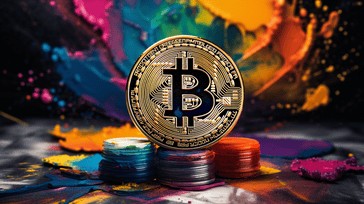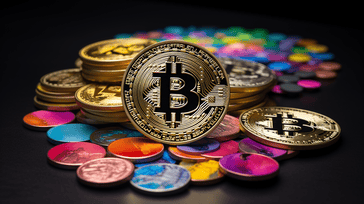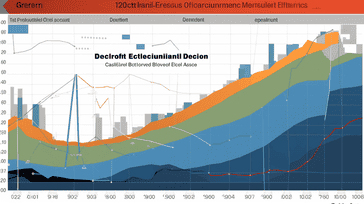
Crypto Currency has been disrupting the financial industry for years, but now it's making its presence known in other sectors, particularly in the art world. Non-Fungible Tokens (NFTs) have opened up new possibilities for digital collectibles, offering creators and collectors alike a way to buy, sell, and own unique pieces of art on the blockchain.
In this article, we'll explore the intersection of art and Crypto Currency through the lens of NFTs. We'll explain the concept of Crypto Currency, provide an introduction to NFTs, and discuss the rise of digital art and its connection to NFTs. We'll also dive into the mechanics of buying and selling NFTs, explore their potential as an investment opportunity, and look ahead to the future of NFTs in the art world and beyond.
Key Takeaways:
- Crypto Currency and NFTs have revolutionized the way we think about digital collectibles.
- NFTs provide a unique way to represent and own digital art on the blockchain.
- The decentralized nature of Crypto Currency makes it an ideal fit for the art world.
- Investing in NFTs can be lucrative, but it's important to understand the risks involved.
- NFTs have the potential to democratize art ownership and empower creators.
Understanding Crypto Currency
As the world becomes increasingly digital, the concept of currency has evolved as well. Crypto Currency, also known as digital currency or virtual currency, is a decentralized form of currency that uses encryption techniques to regulate the generation of units of currency and verify the transfer of funds. Unlike traditional currency, Crypto Currency is not tied to a specific country or government.
The underlying technology behind Crypto Currency is called blockchain. Blockchain is a decentralized digital ledger that records transactions in a secure and transparent manner. Each block in the chain contains a record of several transactions, and once a block is added to the chain, the information it contains cannot be altered.
Crypto Currency is generated through a process called mining, which involves the use of computer power to solve complex mathematical equations. Once a solution is found, a new block is added to the blockchain, and the miner is rewarded with a certain amount of Crypto Currency.
Crypto Currency can be used for a variety of purposes, including online purchases and investments. It is becoming increasingly popular as a means of payment due to its fast and secure transaction process.
Introduction to NFTs

In the world of Crypto Currency, Non-Fungible Tokens (NFTs) have revolutionized the notion of digital collectibles. NFTs are digital assets that are unique and cannot be replaced, replicated, or exchanged for an equal value. Unlike other Crypto Currency, such as Bitcoin or Ethereum, NFTs possess individual characteristics that make them stand out as one-of-a-kind items.
NFTs have opened up new avenues for artists, musicians, and creators to monetize their work through the Crypto Currency market. With NFTs, creators can sell their digital art, music, videos, and other digital assets as unique, one-of-a-kind items. Buyers of NFTs are purchasing the ownership rights of that specific digital asset, and the transaction is recorded on the blockchain, ensuring authenticity and scarcity.
NFTs have been changing the game when it comes to digital ownership and provenance. By leveraging the blockchain technology that powers Crypto Currency, NFTs enable creators to establish ownership rights and sell their digital work directly to buyers, cutting out intermediaries and making transactions more transparent.
"The use of NFTs is like a perfect storm of technology and culture. The development of the blockchain and Crypto Currency markets paved the way for digital artists to really flex their creativity and intellectual property rights. It was just the right time for a new, revolutionary way of digital ownership to emerge."
Overall, NFTs have made it possible for digital creators to monetize their work and showcase their abilities on a global scale, while providing buyers with proof of ownership and the satisfaction of owning something truly unique. This intersection of Crypto Currency and digital collectibles has opened up a new era of ownership and creativity, and the possibilities are endless.
The Rise of Digital Art
The advent of Non-Fungible Tokens (NFTs) has sparked a revolution in the art world, paving the way for the rise of digital art. NFTs, which operate on blockchain technology, offer unique features that allow artists to create, sell, and authenticate their digital artworks in a way that was previously impossible.
One of the primary benefits of creating digital art through NFTs is that artists can guarantee the authenticity and uniqueness of their creations. This is due to the fact that NFTs are stored on a decentralized, immutable ledger, making it virtually impossible to create fraudulent copies of a verified NFT.
The Benefits of Digital Art for Artists
The use of NFTs has opened up new revenue streams for artists. As digital art gains acceptance, artists can profit from the sale of their work in ways that were not possible with traditional art forms. In addition, the use of NFTs allows artists to receive royalties when their work is resold on the secondary market. This is a significant change from the traditional art market, where artists typically receive a one-time fee for their work, and never receive any additional compensation when it is sold in the future.
Furthermore, digital art is not limited by the physical constraints of traditional art forms. This means that artists can create and sell works that are unique, interactive, and often more accessible to a wider audience.
Challenges of Digital Art in the Art World
Although NFTs offer new opportunities for artists, they also present challenges for the art world. Traditional art institutions and collectors are often hesitant to embrace digital art, as it is difficult to define its value and authenticity. Additionally, the intersection of Crypto Currency and art is a new and relatively untested space, and some may be wary of investing in it.
Comparing Digital Art and Traditional Art
| Digital Art | Traditional Art | |
|---|---|---|
| Medium | Electronic files | Paint, sculpture, printmaking |
| Authenticity | Verified by blockchain technology | Authenticated by experts |
| Accessibility | Can be viewed and shared online | Physical presence required |
| Value | Based on market demand and rarity | Based on historical significance and cultural value |
Despite these challenges, digital art is gaining traction in the art world, and the use of NFTs is likely to continue to grow as more artists and collectors discover its benefits.
How NFTs Work

Non-Fungible Tokens (NFTs) function differently from traditional Crypto Currency assets like Bitcoin and Ethereum. NFTs represent unique assets with their own distinct identifiers, making them non-interchangeable with other tokens.
NFTs are created, bought, and sold using blockchain technology. This makes them secure, transparent, and tamper-proof.
Creating NFTs
Creating an NFT involves uploading a digital asset, such as a piece of artwork, onto a blockchain. This process requires the artist to mint the NFT, which serves as a unique identifier and proof of ownership for the digital asset.
The blockchain technology used to create NFTs is called Ethereum. Ethereum is a decentralized platform that enables the creation of smart contracts, which are self-executing contracts with the terms of the agreement between buyer and seller being directly written into lines of code.
Buying and Selling NFTs
NFTs are typically sold through online marketplaces. These marketplaces use Ethereum to facilitate transactions by creating a smart contract between the buyer and seller. Once the transaction is complete, the NFT is transferred to the buyer's digital wallet.
Since NFTs are unique and non-interchangeable, they can be sold for a wide range of prices, depending on the value attributed to the digital asset. Some NFTs have sold for millions of dollars, while others may only sell for a few dollars.
The Role of Smart Contracts
Smart contracts play a crucial role in the buying and selling of NFTs. These contracts allow for automatic and transparent transactions, removing the need for intermediaries like agents or brokers.
Smart contracts also ensure that the original creators of the digital asset receive a percentage of the profits whenever the NFT is sold in the future. This feature allows artists and creators to earn a steady stream of income from their digital assets, even after they have been sold multiple times.
NFTs in the Art World
The impact of NFTs in the art world has been significant, offering artists new ways to monetize their work and establish ownership rights. NFTs are transforming the traditional art industry by allowing for secure and transparent transactions.
"NFTs offer artists a new level of control over their work, allowing them to establish authenticity, provenance, and ownership rights in a secure, transparent, and decentralized way."
One of the key benefits of NFTs in the art world is the ability to provide provenance and authenticity verification. This is important for collectors and investors who seek to purchase genuine artwork. Since NFTs are stored on the blockchain, they provide a permanent record of ownership, including the history of ownership transfers, and any changes made to the artwork.
In addition to providing proof of ownership, NFTs also offer new opportunities for artists to generate revenue. Artists can create and sell digital collectibles directly to their fanbase, who can then buy and sell the NFTs on marketplaces such as OpenSea and Nifty Gateway. This allows artists to engage with their audience in new ways and create a sustainable income stream.
Examples of NFTs in the Art World
Several well-known artists have already embraced NFTs and sold their work for significant sums of money. For example:
| Artist | Artwork | Sale Price |
|---|---|---|
| Beeple | Everydays: The First 5000 Days | $69 million |
| Grimes | WarNymph Collection | $6 million |
| Pak | The Pixelated Collection | $17 million |
These high-profile sales have brought attention to the potential of NFTs in the art world and have sparked a wave of interest from artists, collectors, and investors alike.
As the use of NFTs in the art world continues to grow, it has the potential to democratize art ownership and empower artists to create and sell their work in new and exciting ways. NFTs are truly revolutionizing the intersection of art and Crypto Currency.
Investing in NFTs

As NFTs continue to gain popularity, they are attracting attention from investors looking to capitalize on this emerging market. Investing in NFTs can be a lucrative opportunity, but it's important to understand the risks involved.
Current State of the NFT Market
The NFT market has exploded in recent months, with sales reaching record-breaking numbers. According to data from NonFungible.com, the total value of NFT transactions exceeded $2 billion in the first quarter of 2021 alone.
The cryptocurrency market has been volatile, with frequent spikes and dips, and the NFT market is not immune to these fluctuations. It's essential to do thorough research before investing in NFTs, as the market can be highly unpredictable.
Factors to Consider When Investing in NFTs
When investing in NFTs, it's important to consider several key factors:
- Credibility of the NFT and the creator: It's crucial to do your due diligence on the NFT and the creator before investing. Look for reputable sources and verified information to ensure that the NFT is legitimate and has value.
- Scarcity and rarity: NFTs that are unique or rare tend to have higher value. Consider the rarity of the NFT and the demand for it when making a decision to invest.
- Long-term potential: While some NFTs may be trendy and have a high value in the short-term, it's important to consider the long-term potential of the NFT and whether it will hold its value over time.
Risks of Investing in NFTs
As with any investment, there are risks involved when investing in NFTs. Some of the key risks to consider include:
- Volatility: The NFT market can be highly volatile, with prices fluctuating rapidly. It's important to be prepared for potential losses.
- Fraud: There have been instances of NFT fraud and scams, so it's important to be cautious and do your research before investing.
- Lack of regulation: The NFT market is largely unregulated, which can make it more susceptible to fraud and manipulation.
Conclusion
Investing in NFTs can be a lucrative opportunity for those willing to take the risks. It's important to do your due diligence and consider the key factors before investing. The NFT market is still in its early stages, and there are many unknowns, but with careful research and analysis, investors can take advantage of this emerging market.
Crypto Currency Mining and NFTs
There is a direct connection between Crypto Currency mining and the creation of NFTs. In order to create and verify the unique digital ownership of an NFT, a significant amount of computational power is required.
One of the most popular Crypto Currencies used to create NFTs is Ethereum, which uses a consensus algorithm called Proof-of-Work (PoW). This algorithm requires miners to solve complex mathematical problems to validate transactions and create new blocks. As a reward for their efforts, miners receive a certain amount of Ethereum.
Since NFTs require a significant amount of computational power, it is only natural that Crypto Currency miners are drawn to this market. By selling their computing power to NFT creators, miners can earn additional income while contributing to the overall growth of the Crypto Currency ecosystem.
Crypto Mining and the Environmental Impact
However, it is important to note that Crypto Currency mining, particularly PoW mining, has come under scrutiny for its significant energy consumption and environmental impact.
In fact, according to the Cambridge Bitcoin Electricity Consumption Index, Bitcoin mining alone uses more electricity than the entire country of Argentina. This has led to concerns about the sustainability of Crypto Currency mining and how it may contribute to climate change.
Efforts are being made to address these concerns, with some Crypto Currency projects transitioning to more energy-efficient consensus algorithms, such as Proof-of-Stake (PoS). PoS requires less computational power and offers a more eco-friendly alternative to PoW.
The Future of Crypto Mining and NFTs
Despite the challenges associated with Crypto Currency mining, the market for NFTs continues to grow. As more artists and creators recognize the potential of NFTs as a means of monetizing their work, the demand for Crypto Currency mining power is likely to increase.
It remains to be seen how the Crypto Currency mining industry will adapt to meet this demand while addressing the concerns around energy consumption and sustainability. However, as the market for NFTs continues to develop, it is clear that Crypto Currency mining will remain an essential component of this digital economy.
Storing NFTs: Crypto Wallets
To ensure the security of NFTs, it is essential to store them in a Crypto Currency wallet. A crypto wallet is a digital wallet that stores your NFTs and other Crypto Currency assets. There are several types of crypto wallets available, including:
- Hardware wallets: These are physical devices that store your NFTs offline, making them less susceptible to hacks. Examples include Ledger Nano S, Trezor, and KeepKey.
- Software wallets: These are digital wallets that can be accessed through mobile or desktop applications. Examples include MetaMask, MyEtherWallet, and Trust Wallet.
- Web wallets: These are online wallets that can be accessed through a web browser. Examples include Coinbase Wallet and Binance Chain Wallet.
When choosing a crypto wallet, it's important to consider factors such as security, ease of use, and compatibility with the NFT marketplace you plan to use. It's also crucial to keep your wallet's private keys secure, as they are used to access your NFTs and other Crypto Currency assets.
Overall, a secure crypto wallet is vital for storing and managing NFTs, allowing you to keep them safe and accessible for future transactions.
NFTs and Decentralized Finance
One of the most exciting applications of NFTs is in the world of decentralized finance (DeFi). DeFi is a new system of finance built on top of blockchain technology that aims to make financial transactions more accessible, transparent, and secure.
By leveraging the unique attributes of NFTs, DeFi platforms are able to offer new financial products and services. For example, NFTs can be used as collateral in DeFi lending platforms, allowing individuals to borrow Crypto Currency against the value of their NFTs.
This has the potential to open up new opportunities for artists and collectors, as they can use their NFT collections to access liquidity without having to sell their digital assets. It also creates a new market for NFTs, where their value is not only determined by their artistic and cultural significance but also by their financial potential.
Case Study: NFTs and DeFi Platforms
Let's take a look at how NFTs are being used in DeFi platforms:
| Platform | Use Case |
|---|---|
| Aave | NFT-backed loans |
| Bondly | NFT marketplace and collateralization |
| Nexus Mutual | Insurance for NFTs |
These examples demonstrate how NFTs are being integrated into the broader Crypto Currency market and open up new opportunities to monetize digital assets. As DeFi continues to grow and mature, we can expect to see more innovative use cases for NFTs and other Crypto Currency assets.
Overall, the intersection of NFTs and DeFi has the potential to create a more inclusive and democratic financial system, where everyone has access to financial services and products, regardless of their location or social status.
NFTs: The Future of Art
The rise of NFTs has the potential to revolutionize the art world, creating new opportunities and challenges for artists and collectors alike. By combining the digital nature of Crypto Currency with the unique attributes of NFTs, we are witnessing a new era of art ownership and distribution.
Democratizing Art Ownership
NFTs have the potential to democratize art ownership, allowing artists to sell their work directly to collectors without the need for intermediaries. This eliminates the traditional barriers to entry in the art market, giving emerging artists a platform to showcase their talent and grow their fanbase.
Additionally, NFTs provide a way for art collectors to own a piece of digital art in a way that was previously impossible. With NFTs, collectors can establish ownership rights and even resell their digital art in secondary markets, creating new revenue streams for both artists and collectors.
New Revenue Streams for Artists
NFTs also provide new revenue streams for artists, who can now monetize their work through the Crypto Currency market. This allows artists to reach a global audience, without the need for traditional galleries or auction houses.
Furthermore, NFTs provide a way for artists to engage with their audience in new and exciting ways. For example, some artists have used NFTs to create limited edition digital art that is only available to certain fans or collectors, creating a sense of exclusivity and community.
Challenges and Opportunities
While NFTs offer many benefits to the art world, there are also challenges and potential downsides to consider. For example, some artists and critics have raised concerns about the environmental impact of Crypto Currency mining, which is necessary for the creation and verification of NFTs.
However, as the technology behind NFTs continues to evolve, we can expect new solutions and innovations to address these challenges and unlock even more potential for the intersection of art and Crypto Currency.
Conclusion
NFTs are a transformative technology that has the potential to reshape the art world as we know it. By democratizing art ownership, creating new revenue streams for artists, and offering new opportunities for collectors, NFTs are changing the way we think about art and its value in the digital age.
Conclusion
In conclusion, NFTs are a game-changer at the intersection of art and Crypto Currency. They offer a unique way for artists to monetize their digital works and establish ownership rights in a decentralized manner. The benefits of NFTs extend beyond the art world, as they have the potential to revolutionize industries across the board.
The rise of digital art and the emergence of NFTs have opened up new creative and revenue streams, empowering artists to showcase their works in innovative ways. NFTs have also given rise to new investment opportunities in the Crypto Currency market, although caution is advised due to their volatility.
As the market for NFTs continues to grow, it is essential to prioritize secure storage and management of these assets using trusted crypto wallets. Additionally, NFTs have the potential to revolutionize the financial sector through their use in decentralized finance applications.
The Future of NFTs
The future of NFTs remains highly promising, with potential for further innovation in the art world and beyond. NFTs hold the key to democratizing art ownership, empowering artists, and transforming industries through the decentralized nature of Crypto Currency. As the market for NFTs matures, we can expect to see further exciting developments in this space.
Overall, NFTs have the potential to transform the world of art and Crypto Currency, ushering in a new era of creativity and financial opportunity. As the intersection of these two worlds continues to evolve, it will undoubtedly be exciting to see what the future holds.
FAQ
What are Non-Fungible Tokens (NFTs)?
Non-Fungible Tokens (NFTs) are unique digital assets that represent ownership or proof of authenticity for a specific item or piece of content, such as digital art, music, videos, or virtual real estate.
How do NFTs differ from traditional Crypto Currency assets?
While traditional Crypto Currency assets like Bitcoin and Ethereum are fungible and can be exchanged on a one-to-one basis, NFTs are unique and cannot be exchanged on a like-for-like basis. Each NFT has a distinct value and set of properties, making it one-of-a-kind.
How are NFTs created and purchased?
NFTs are created using blockchain technology, which ensures their authenticity and scarcity. They can be purchased through various online marketplaces and auction platforms that specialize in the trading of NFTs.
What is the role of blockchain technology in NFTs?
Blockchain technology provides a decentralized and transparent ledger that records the ownership and transaction history of NFTs. It ensures the security and integrity of NFTs by preventing fraud and unauthorized duplication.
Can NFTs be sold or traded?
Yes, NFTs can be sold or traded on the secondary market, allowing owners to profit from the increased value of their digital assets. The transaction process is facilitated by blockchain technology and smart contracts, which automatically execute the terms of the sale or trade.
Are there any risks associated with investing in NFTs?
Like any investment, there are risks involved in investing in NFTs. The value of NFTs can be volatile, and the market for digital collectibles is still relatively new and evolving. It's important to do thorough research and understand the potential risks before making any investment decisions.
How do I store my NFTs?
NFTs are typically stored in specialized crypto wallets that support their unique properties. These wallets provide secure storage and management of NFTs, allowing you to easily view, buy, sell, and transfer your digital assets.
Can NFTs be used as collateral in decentralized finance (DeFi) platforms?
Yes, NFTs can be used as collateral in certain DeFi lending platforms. This allows NFT owners to borrow against the value of their digital assets, unlocking liquidity without needing to sell their NFTs.
What is the future potential of NFTs in the art world?
NFTs have the potential to revolutionize the art world by providing new ways for artists to monetize their work, establish ownership rights, and engage with their audience. They offer increased accessibility and transparency, potentially democratizing art ownership and empowering artists in the digital era.







